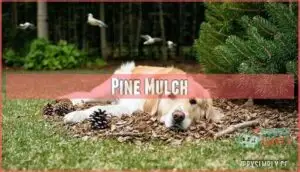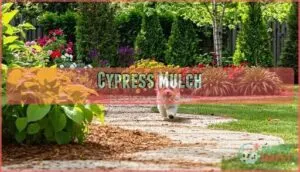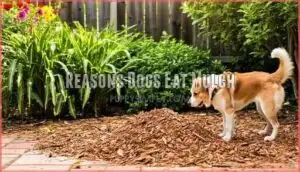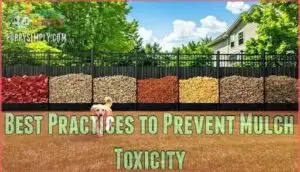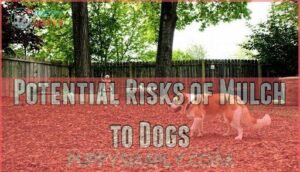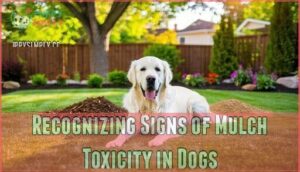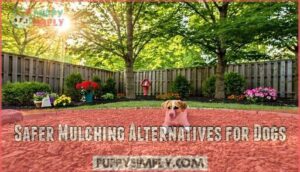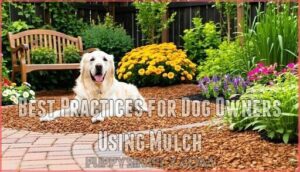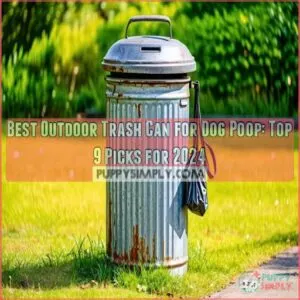This site is supported by our readers. We may earn a commission, at no cost to you, if you purchase through links.
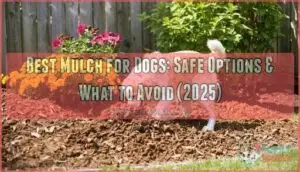 You step outside with your dog, coffee in hand, admiring your freshly mulched garden—only to spot your four-legged companion munching away on the new ground cover.
You step outside with your dog, coffee in hand, admiring your freshly mulched garden—only to spot your four-legged companion munching away on the new ground cover.
For many dog owners, mulch is both a landscaping hero and an unexpected source of worry. What keeps your hydrangeas healthy could spell trouble for your pup’s curious nose and teeth. Knowing the best mulch for dogs isn’t just about keeping the yard tidy; it’s about peace of mind for every backyard adventure.
If you want beautiful beds without putting your dog at risk, you’re in the right place.
Table Of Contents
- Key Takeaways
- Safe Mulch Options for Dogs
- Reasons Dogs Eat Mulch
- Best Practices to Prevent Mulch Toxicity
- Potential Risks of Mulch to Dogs
- Recognizing Signs of Mulch Toxicity in Dogs
- Safer Mulching Alternatives for Dogs
- Best Practices for Dog Owners Using Mulch
- Frequently Asked Questions (FAQs)
- Is Cedar mulch safe for dogs?
- What is the best mulch for dogs?
- How do I choose the right mulch for my Dog?
- Is Mulch safe for dogs?
- Is rubber mulch safe for dogs?
- How often should mulch be replaced in dog areas?
- Can mulch attract fleas or other pests to my yard?
- Does weather affect the safety of dog-friendly mulch?
- Are there specific mulches that deter digging in dogs?
- What’s the best way to clean mulch after rain?
- Conclusion
Key Takeaways
- Pine, cypress, and cedar mulches are your safest bets for dog-friendly yards—they’re non-toxic, naturally pest-repelling, and won’t cause harm if your pup decides to nibble, unlike cocoa mulch which contains theobromine and can trigger seizures or worse.
- Watch for behavioral red flags like sudden vomiting, excessive scratching, lethargy, or personality shifts after mulching—these symptoms can escalate from mild stomach upset to life-threatening emergencies requiring immediate vet attention.
- Physical barriers, regular yard inspections, and basic training go further than perfect mulch selection alone—supervision and smart landscaping design prevent most mulch-related incidents before they start.
- Skip chemically treated, dyed, or rubber mulches in high-traffic dog areas—even "safe" options can cause allergic reactions or blockages, so stick with untreated natural wood products and monitor your dog’s response closely.
Safe Mulch Options for Dogs
When you’re adding mulch to your yard, you want something that looks good and keeps your dog safe. The good news is that plenty of natural mulches fit the bill without toxic ingredients or sharp edges.
Landscape pros point to several standout options that won’t put your pup at risk.
Pine Mulch
If you’re looking for a mulch that won’t break the bank and keeps your dog’s tail wagging, pine mulch might just be your yard’s new best friend. Here’s why this natural option deserves a spot in your garden:
- Budget-friendly choice – Pine bark and pine needle straw offer excellent value without sacrificing quality
- Natural pest deterrent – Helps ward off unwelcome bugs while maintaining soil health
- Moisture retention – Keeps your yard maintenance manageable by reducing watering needs
- Pleasant aesthetics – Fresh, woodsy scent enhances garden safety and appeal
Beyond saving you money, pine mulch offers real practical advantages.
It’s typically safe for dogs, though you’ll want to keep an eye out if your pup starts chewing it or seems uncomfortable.
Your dog gets a soft surface that’s easy on their paws, and your plants get the natural support they need.
Cypress Mulch
Cypress mulch steps up as another winner in the dog-safe category, bringing natural pest control and lasting durability to your yard without the hefty price tag. Its natural oils work as insect repellents, keeping fleas and other pests away from your dog’s outdoor hangout. Unlike cocoa mulch—which contains toxic theobromine—cypress mulch won’t tempt your pup into dangerous snacking.
Beyond keeping pests at bay, cypress mulch handles erosion like a champ and cuts down on the time you spend fussing with your yard.
The shredded bark stays gentle on paws and won’t poison your dog if they decide to investigate.
Plus, it looks right at home tucked around your flowers and veggie beds.
Just maintain a reasonable depth to prevent tripping hazards, and watch for any unusual reactions in your dog. With proper mulch safety for dogs practices, cypress mulch creates a beautiful, functional space where your furry friend can play worry-free.
Reasons Dogs Eat Mulch
If you’ve ever caught your pup munching on mulch, you’re not alone—it’s surprisingly common. Understanding why dogs are drawn to mulch can help you prevent problems before they start.
Let’s look at the three most common culprits.
Curiosity
Ever wonder why your dog seems magnetically pulled to that fresh pile of mulch you just spread across the garden? Curious behavior drives this pet inspection ritual. Dogs explore through their noses and mouths, investigating new textures and scents in their environment. That mulch you carefully laid down? It’s basically an all-you-can-sniff buffet.
The key to yard safety is redirecting this natural dog exploration instinct. Offer textured chew toys, choose safe mulch options like untreated wood chips, and create designated digging zones.
Not all mulch is created equal—some types can actually be dangerous if your dog decides to sample them. What starts as innocent sniffing can quickly become a vet visit if you’ve got cocoa mulch or treated wood chips in the yard.
The good news? A little planning goes a long way in keeping your pup safe while they satisfy their curiosity.
Exploration
Your pup doesn’t just sniff the mulch—they want to really experience it with their paws, nose, and mouth. This mulch exploration behavior is hardwired into their DNA. Different textures, buried critters, and interesting smells turn your garden into an adventure zone. Smart yard design with pet-friendly mulch like cedar or pine bark protects against toxic mulch risks.
Keeping your garden safe for curious pups:
- Choose the best mulch for dogs—untreated wood chips or cypress work great
- Create designated digging zones away from mulch beds
- Install low barriers around dog-safe mulch areas to discourage pawing
- Use mulch safety for dogs principles—avoid cocoa or chemically treated options
- Schedule regular checks for mold or debris in your pet-friendly mulch
Chewing
Some dogs treat mulch like a giant buffet of chew toys, gnawing on bark chunks and wood pieces whenever boredom strikes. This chewing habit stems from natural instincts—puppies explore their world mouth-first, and older dogs seek mental stimulation.
When your yard becomes their entertainment center, toxic mulch poses real dog health risks. Redirect these chewing habits with proper dog training and designated chew prevention strategies.
Swap risky materials for mulch alternatives like cedar or untreated wood chips that discourage nibbling. Combine pet safety-smart choices with plenty of appropriate toys, and you’ll protect your pup from mulch toxicity while keeping your garden intact. Win-win for everyone.
Best Practices to Prevent Mulch Toxicity
You don’t need to overthink mulch safety for your dog. A few simple steps can prevent anything from mild stomach upset to a rushed trip to the vet.
Here’s how to keep your pup safe around mulch.
Avoid Toxic Mulches
When it comes to mulch, what’s safe for your garden isn’t always safe for your dog. Cocoa mulch is the worst offender—it’s packed with theobromine, the same toxin that makes chocolate dangerous for dogs.
Dyed mulch and chemically treated varieties can be just as risky, since they contain substances that could harm your pup if they decide to take a taste.
Here are the dangers of mulch for dogs you’ll want to steer clear of:
- Cocoa Bean Mulch: Contains theobromine, which triggers vomiting, seizures, and worse.
- Chemically Treated Mulches: Loaded with preservatives and dyes that spell trouble.
- Rubber Mulch: Often contains lead or zinc and poses choking risks.
Stick with non-toxic alternatives like untreated pine, cedar, or cypress to keep your yard safe.
Monitor Allergic Reactions
Even the safest mulches can surprise you with an allergic reaction, so watch how your dog acts after you lay down fresh material. Cedar oils and other natural compounds might bother some dogs, even in non-toxic varieties.
Watch for these allergy symptoms that signal your pup might be having an allergic reaction:
- Excessive scratching, licking, or chewing at paws
- Skin irritation like redness, rashes, or hot spots
- Sneezing, watery eyes, or respiratory discomfort
- Gastrointestinal problems including vomiting or diarrhea
Reaction prevention starts with monitoring your dog closely for the first few days after mulching. If you notice health issues developing, switch to a different material—some dogs simply can’t tolerate certain natural oils or compounds. When in doubt, your vet can help identify mulch allergies and recommend alternatives.
Potential Risks of Mulch to Dogs
Different types of mulch pose different risks to your dog’s safety. Some contain ingredients that can seriously harm your pup, while others present physical dangers you might not anticipate.
Here are the main types to avoid in your yard.
Cocoa Mulch
Cocoa bean mulch smells like chocolate, which makes it dangerously tempting to dogs—but it’s packed with theobromine, the same toxin found in chocolate. Even a few ounces can cause serious dog health risks, from vomiting and tremors to seizures.
- Theobromine levels up to 1200 mg per ounce
- Attractive chocolate aroma lures dogs
- Symptoms appear within 1–4 hours
- Small breeds face higher toxicity levels
- Choose safer mulch alternatives instead
Skip cocoa mulch entirely. The cocoa hazards aren’t worth the gamble when pet safety alternatives like pine or cedar work beautifully without the risk of mulch toxicity. Dog owners should be aware of the cocoa mulch toxicity risks to keep their pets safe.
Bark Mulch
Bark mulch looks harmless enough sitting in neat piles at the garden center, but it can pack a few nasty surprises for your four-legged friend. Large chunks become choking hazards, while damp bark breeds bacteria.
Chemically treated or dyed bark-based mulches introduce toxins your dog doesn’t need. If you’re going for natural mulch options like pine bark or cedar mulch, choose untreated varieties and keep an eye on your pup during yard maintenance.
Grass Clippings
Your freshly mowed lawn might seem like free mulch, but those innocent-looking grass clippings can actually cause more trouble than they’re worth. When clippings sit in damp piles, they ferment and breed bacteria that upset your dog’s stomach. If you’ve used grass fertilizers or practiced lawn aeration with chemical treatments, those toxins transfer straight to your pup’s paws and mouth.
Consider these pet-safe landscaping materials instead:
- Cedar or pine bark mulch – Natural options without the fermentation risk
- Untreated wood chips – Stable coverage that won’t decompose quickly
- Straw mulch – Budget-friendly yard waste alternative for dog health risks
Compost
Grass clippings are one thing, but compost piles present an entirely different risk for dogs. Sure, composting does wonders for soil enrichment and cutting down waste—but that decomposing organic matter becomes a magnet for mold and bacteria that can seriously harm your pup.
That natural fertilizer you’re creating? It can trigger mulch allergies or worse—compost toxicity from food scraps and organic mulch decomposition.
Keep your pet-friendly mulch strategy simple: secure that compost with sturdy barriers, choose safer alternatives for areas where your pup roams, and save those soil enrichment perks for spaces your dog can’t access.
Other Hazards
Beyond compost piles, your yard might be hiding some unexpected dangers that could turn your dog’s playtime into a trip to the vet. Watch out for these sneaky hazards:
- Chemical exposure: Insecticides and fertilizers mixed into mulch can trigger gastrointestinal upset
- Sharp objects: Rocks, glass, or metal bits hiding in mulch layers
- Chunky pieces: Large chunks create a choking hazard or blockage risk
- Pest control products: Rodenticides near mulched areas spell trouble
- Fungal growth: Mold spores cause mulch allergies and respiratory issues
Recognizing Signs of Mulch Toxicity in Dogs
If your dog gets into the wrong mulch, catching the warning signs early can make all the difference. Symptoms of toxicity range from mild stomach upset to serious complications that need immediate care.
Here’s what might signal trouble—so you know when to get help.
Gastrointestinal Upset
One minute your dog seems fine, and the next they’re hunched over, miserable—that’s how quickly gastrointestinal upset from mulch can hit. Vomiting and diarrhea are your first red flags, especially if they’re sudden. You might also notice your pup refusing meals or whining from stomach pain—classic digestive issues that shouldn’t be ignored.
Smaller mulch particles pose an extra risk—they can create dangerous intestinal blockages that escalate fast, compromising your dog’s health and safety. Opt for dog-friendly mulch alternatives to prevent such hazards.
| Symptom | What It Means |
|---|---|
| Vomiting/diarrhea | Possible mulch toxicity or food poisoning |
| Loss of appetite | Stomach problems or intestinal blockage developing |
| Hunched posture/whining | Abdominal pain requiring vet attention |
Changes in Behavior
Sometimes stomach troubles are just the beginning—dogs dealing with mulch toxicity often start showing personality shifts that catch you completely off guard. Your normally calm pup might suddenly snap at other pets, or your social butterfly could hide under the bed. These behavioral alerts matter—they’re your dog’s way of saying something’s wrong.
Watch for these canine reactions:
- Sudden aggression toward people or other animals
- Anxiety signs like excessive panting or pacing
- Withdrawal from normal activities and play
- Restlessness or inability to settle down
- Unexplained fearfulness in familiar situations
If you notice behavior changes after your dog’s been around mulch, especially dog-friendly mulch varieties like cedar, don’t wait—pet monitoring and quick vet attention protect your dog’s health and prevent toxicity symptoms from escalating.
Physical Discomfort
Dogs experiencing mulch toxicity often show their distress through physical signs you can actually see and touch—scratching fits that won’t quit, constant paw licking, or unusual sensitivity when you pet their belly. These symptoms reveal how your dog’s body reacts to toxic mulch materials, creating real pet safety concerns.
| Physical Sign | What It Looks Like | Why It Matters |
|---|---|---|
| Skin irritation | Red, inflamed patches or hives | Signals allergic reactions to mulch chemicals |
| Paw problems | Excessive licking, limping, swollen pads | Could indicate contact with sharp mulch or insect bites |
| Digestive issues | Bloating, gas, abdominal tenderness | Warning sign of choking hazard or blockage |
| Coat changes | Dull fur, bald spots, constant scratching | Shows your dog’s overall health is compromised |
Watch your pup closely—mulch toxicity doesn’t always announce itself with drama, but these physical clues tell you everything you need to know about dog health risks lurking in your yard.
More Serious Symptoms
When mulch toxicity escalates beyond stomach upset, your dog faces life-threatening emergencies that demand immediate veterinary attention. Seizures can strike within 6–12 hours of ingesting cocoa mulch, while cardiac arrhythmias signal dangerous toxicity levels requiring emergency care.
Watch for these critical warning signs:
- Seizures or uncontrollable muscle tremors
- Rapid heart rate or irregular breathing
- Severe lethargy progressing to collapse
- Kidney failure symptoms (little to no urination)
Organ damage from mulch toxicity isn’t reversible at home—fatal outcomes occur when digestive issues turn into full-body system failure, so don’t wait to see if symptoms improve on their own.
It’s vital to understand the risks of cocoa mulch toxicity to take preventive measures and safeguard your dog’s safety.
What to Do if You Suspect Toxicity
The moment you suspect mulch poisoning, skip the internet rabbit hole and grab your phone. Call your vet or the Pet Poison Helpline immediately—they’ll guide you through first aid based on the mulch type and toxicity symptoms you’re seeing.
Don’t induce vomiting without vet advice—some mulches cause more damage coming back up.
| Action | When to Use |
|---|---|
| Contact vet immediately | Any suspected mulch toxicity |
| Call ASPCA Poison Control | After-hours emergencies |
| Document symptoms | Before emergency care visit |
Safer Mulching Alternatives for Dogs
Want to keep your dog safe without sacrificing your landscaping? There are plenty of mulch options that work well for both your yard and your four-legged friend.
Not all mulches are created equal, and choosing the right one can give you peace of mind while keeping your yard looking great.
Here’s a breakdown of dog-friendly mulches that balance safety, function, and practicality.
Cedar Mulch
If you want a mulch that works double duty—keeping your yard looking sharp while naturally keeping bugs at bay—cedar is worth your attention. Its pleasant aroma and rich color boost garden aesthetics while providing pet comfort underfoot. Cedar benefits include moisture retention and natural pest control, making yard maintenance easier.
- Natural cedar chips repel fleas and ticks
- Red cedar pet bedding properties translate well to outdoor use
- Cedar shavings mulch offers garden safety without harsh chemicals
Rubber Mulch
Ever picture a mulch tough enough for wild fetch marathons? Rubber mulch delivers on durability, bouncing back from playtime wear and tear without splintering or harboring pests.
As an eco-friendly, pet-safe landscaping material, it offers smart Rubber Safety—just keep an eye out for curious nibblers.
For foolproof garden maintenance and reduced pet hazards, it’s a new favorite for dog safety in gardens.
Untreated Wood Chips
Nothing says “welcome, paws and all” quite like a garden floor cushioned with untreated wood chips. This pet-friendly mulch is a crowd favorite for Mulch Safety, with zero hidden chemicals and natural durability under zoomies.
Choose chip sizing carefully—thicker chips cover your yard evenly and stay put, even when dogs dig in. Untreated wood mulch, including cedar mulch, promotes Eco Friendliness and makes cleanup a breeze.
For anyone prioritizing mulch for dogs, you can’t beat the honest simplicity—and peace of mind—these dog-safe mulch chips provide.
Straw Mulch
After untangling the perks of untreated wood chips, let’s chat about straw mulch—a gentle, wallet-friendly choice that’s just as welcoming under curious paws.
Straw mulch benefits include quick decomposition, making it a go-to for eco mulch alternatives and organic mulching.
For pet-friendly options, pine needle straw is soft, but always keep straw moist and regularly replaced for garden safety tips and mulch safety for dogs.
Best Practices for Dog Owners Using Mulch
Dog safety around mulch goes beyond choosing the right material—how you apply and maintain it matters just as much.
To help, here are a few straightforward practices every dog owner should know. Let’s walk through the key steps to keep your garden both dog-friendly and beautiful.
Use Physical Barriers
Every sturdy gate or simple garden fence you add makes it that much harder for curious pups to end up where they shouldn’t. Want ideas for a dog-friendly yard that really works? Try:
- Solid fence installation around mulch beds
- Gate security latches that dogs can’t nudge open
- Yard blocking with raised planters
- Barrier materials like lattice or garden edging
- Outdoor enclosures for safe play zones
These physical barriers, combined with petsafe landscaping materials, bring peace of mind to petfriendly yard design and keep dog safety in gardens top of mind.
Regular Garden Check-ups
Once you’ve built that fence or set up barriers, it’s worth making a stroll through your yard a regular habit to keep everything safe and in good shape. These quick garden inspections make a world of difference—spotting loose mulch, sniffing out trouble, and protecting your dog’s wellness is easier than you think:
| Garden Inspection | Dog Wellness Boost |
|---|---|
| Mulch Monitoring | Fewer tummy troubles |
| Pet Safety Checks | Safer, happier play outside |
| Yard Maintenance | Clean, mud-free paws |
| Remove hazards early | Peace of mind for you |
Training Importance
Walking the yard is half the job—teaching your dog how to behave around mulch is where the real magic happens.
Rely on Positive Reinforcement and smart Reward Systems to lock in good habits. With Canine Obedience training and everyday supervision, you’ll shape behavior changes that stick, keeping your pet-safe gardening plans on track and your dog’s curiosity in check.
Consult Professionals
When you’re not sure what’s best for your yard and your pup, lean on the experts.
Veterinarians offer spot-on Veterinary Advice, while Soil Experts and Garden Designers rely on a Mulch Selection Guide to help you figure out:
- Dog safety in gardens with petfriendly landscaping
- Professional landscaping and mulch testing tips
- Making a petfriendly yard design reality
Supervision
Most days, just a little extra attention outside can save you and your pup a whole lot of worry. Constant monitoring and a bit of “Garden Patrol” mean you’ll spot trouble—like mulch munching—before it starts.
Outdoor vigilance isn’t just Pet Watch; it’s about shaping a truly dog-friendly yard, where supervision and PetSafe landscaping materials keep dog safety in gardens a top priority.
Frequently Asked Questions (FAQs)
Is Cedar mulch safe for dogs?
Cedar mulch is a top pick for pet-friendly landscaping. Its pleasant smell naturally repels bugs, and it’s generally considered a dog-friendly mulch.
Just keep an eye out for mulch allergies or chewing, as even pet-safe mulch isn’t snack food.
What is the best mulch for dogs?
Looking for the best mulch for dogs? Pine bark, cypress, and cedar mulches are top picks.
These mulch materials prioritize pet safety, yard design, and dog health—plus, they’re naturally bug-repelling and blend seamlessly into petfriendly gardening.
How do I choose the right mulch for my Dog?
Choosing mulch for dogs means prioritizing Pet Safety over yard trends—opt for pine bark, cedar, or untreated wood chips. Skip cocoa and eucalyptus.
The best mulch for dogs balances Dog Health, Garden Maintenance, and yard design aesthetics.
Is Mulch safe for dogs?
Mulch safety for dogs really depends on what’s in your yard. While pine, cedar, and cypress are dog-friendly mulch choices, steer clear of toxic mulches like cocoa or dyed varieties—pet health comes first in avoiding garden risks.
Is rubber mulch safe for dogs?
Think of rubber mulch like a padded playground—soft and long-lasting for your dog’s paws, but risky if munched.
For pet safety, always supervise play, use a petsafe mulch, and practice toxicity prevention to avoid health concerns.
How often should mulch be replaced in dog areas?
Plan for Mulch Replacement every one to two years in dog-friendly yards, though high-traffic zones may need freshening each season.
Dog Area Maintenance is all about Yard Sanitation, Pet Safety Tips, and regular Garden Renewal for dog health.
Can mulch attract fleas or other pests to my yard?
Some mulches can make your yard more appealing to fleas and other pests, especially if yard sanitation slips.
Smart Pest Control Methods, using Natural Deterrents and Organic Pest Management, help balance flea attraction factors with safe pest deterrence.
Does weather affect the safety of dog-friendly mulch?
Rain soaks, sun bakes, winds scatter—weather impact shapes how dog-friendly mulch holds up.
Changes in moisture levels or temperature effects can speed mulch degradation, alter moisture retention, or even increase mulch toxicity depending on climate and weather patterns.
Are there specific mulches that deter digging in dogs?
Some dog owners swear by mulch textures like large pine bark or chunky cedar as mild Digging Deterrents.
Pairing dog-safe mulch options with Yard Barriers or basic Dog Training Tips can make your garden less tempting to curious paws.
What’s the best way to clean mulch after rain?
After a downpour, you’ll find clumps and compacted areas need attention. Rake through damp mulch to improve yard drainage and aeration—this promotes mulch drying and prevents odor control issues that attract curious pups to investigate.
Conclusion
Sure, you could line your beds with broken glass and razor wire—perfectly safe if Fido just stops being so curious, right? The reality is simpler: choosing the best mulch for dogs means picking materials that won’t poison, puncture, or provoke panic when they inevitably get sampled.
Choosing dog-safe mulch means picking materials that won’t poison, puncture, or provoke panic when inevitably sampled
Pine, cypress, and cedar top the list, while cocoa mulch stays firmly on the "never" list. Your garden can look stunning and stay safe—you just need to choose wisely and stay vigilant.

